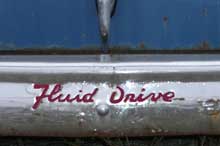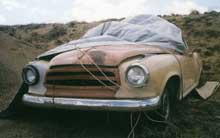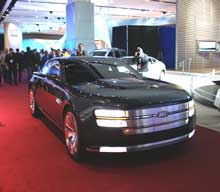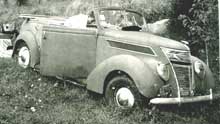Fluid Drive
Everybody knows that Fluid Drive was Chrysler Corporation's answer to Hydra-Matic, and that it goes "clunk" when it shifts. Everybody's half right. Indeed, Fluid Drive, introduced on Chrysler cars for 1939 and extended to DeSoto and Dodge in 1941, was Chrysler's weapon in the shiftless wars, arriving a year before Hydra-Matic and proving to be much more successful than the Reo Self Shifter and Lincoln's ill-fated Liquimatic. But Fluid Drive doesn't clunk - it doesn't even shift.
That's because Fluid Drive is simply a fluid flywheel, a concept employed by the British Daimler as early as 1933. As Chrysler explained it, a "driving wheel" attached to the engine is filled with a "special oil" (the fluid) which exerts force on a "runner wheel" that connects to the driveshaft ("Gyrol" refers to the "special oil;" the fluid couplings were developed in Germany). As the driver is spun faster and faster the runner turns with it, in a smooth application of power.
Instead of the repetitious routine of clutching and shifting a conventional car, one merely drops the Chrysler into high and steps on the gas. The result is a smooth getaway. Not just more convenient, it was safer, too - and easier on the car. This "cushion of power" was said to be trouble free - and thrilling. As thrilling, apparently, as driving a destroyer or a submarine. "Adopted in 1938" pertains to the 1939 model year, and the 1945 date on this brochure suggests that no innovation since 1915 was as noteworthy.
You note it says nothing about shifting. That's because Fluid Drive, in its basic form, is just the fluid flywheel and a standard clutch. When ordered on a Dodge, that's all you got. Drop it into third and go - smoothly but with destroyer-like acceleration. You did have to use the clutch, which Chrysler called a "Safety Clutch," to get into gear, but afterwards all your driving was with your right foot. On Chrysler and DeSoto, though, it could be coupled to a transmission that shifted itself. This was actuated with vacuum, called Vacamatic by Chrysler and Simplimatic in DeSoto. There were two gears in each of two ranges, and the shift was actuated by lifting the throttle and waiting for the clunk. You could get Fluid Drive without Vacamatic/Simplimatic, but not vice versa.
After World War II, a new hydraulically-shifted transmission was used, designated "M5" (Vacamatic and Simplimatic were apparently M4; I don't know what M1 to M3 were). Chrysler's was called "Prestomatic," DeSoto's "Tip-Toe Shift," but all else was the same. Interestingly, although "matic" was the industry-wide suffix for self-shifting, widely touted, Chrysler didn't announce it on their cars. There were no Vac/Simpli/Presto/TipToe emblems. The cars simply said "Fluid Drive," on Dodge's rear bumper, DeSoto's front fender and Chrysler's stop lamp. DeSoto also put it on the glove box.
But wait, there's more - only not right now. The story of Fluid Drive post-1948 will have to wait for another time.




